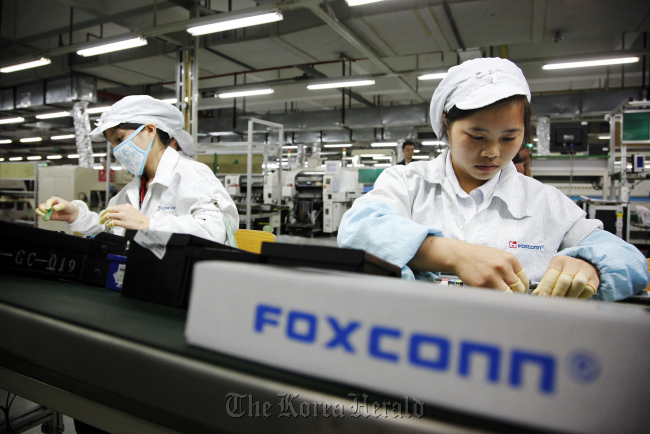Country’s labor costs to equal U.S. within four years
BEIJING (AFP) ― Rapid wage increases are threatening China’s competitiveness, but improved productivity and other advantages mean it will continue to attract investors, analysts say.
Labor costs in China would match those of the United States within four years, catching up with eurozone countries in five years and with Japan in seven, the French bank Natixis forecast in a study last month.
China “will soon no longer be a competitive place for production given the strong rise in the cost of production,” the bank said.
It is a view backed by the respected Boston Consulting Group, which said in a study last August that by around 2015 manufacturing in some parts of the United States would be “just as economical as manufacturing in China.”
Examples of major manufacturers leaving China abound ― BCG said U.S. technology giant NCR has moved its manufacture of ATMs to a factory in Columbus, Georgia, that will employ 870 workers as of 2014.
BEIJING (AFP) ― Rapid wage increases are threatening China’s competitiveness, but improved productivity and other advantages mean it will continue to attract investors, analysts say.
Labor costs in China would match those of the United States within four years, catching up with eurozone countries in five years and with Japan in seven, the French bank Natixis forecast in a study last month.
China “will soon no longer be a competitive place for production given the strong rise in the cost of production,” the bank said.
It is a view backed by the respected Boston Consulting Group, which said in a study last August that by around 2015 manufacturing in some parts of the United States would be “just as economical as manufacturing in China.”
Examples of major manufacturers leaving China abound ― BCG said U.S. technology giant NCR has moved its manufacture of ATMs to a factory in Columbus, Georgia, that will employ 870 workers as of 2014.

Adidas announced recently that it would close its only directly owned factory in China, becoming the latest major brand to shift its manufacturing to cheaper countries, though it maintains a network of 300 Chinese contractors.
Chinese workers making athletic shoes are paid at least 2,000 yuan ($313) a month, while their Adidas colleagues in Cambodia only earn the equivalent of 107 euros, the German company said.
Underlining the trend, the salaries of Chinese urban-dwellers rose 13 percent in the first half of 2012 compared with the same period last year, the government said in mid-July.
Migrant workers, who are among the lowest-paid in the country, saw raises of 14.9 percent for an average of 2,200 yuan a month.
The most significant wage hikes in 2010 and 2011 often came following strikes at Japanese companies such as Toyota and Honda and a wave of suicides at the factories of the Taiwanese electronics giant Foxconn.
Natixis said the increases could spur manufacturers to relocate to South and Southeast Asia, where labor costs are much lower, and could also benefit countries such as Egypt and Morocco, or even European ones like Romania and Bulgaria.
However, not all economists believe China will lose its manufacturing edge, thanks in part to improvements in productivity.
“Most of the increase in wages has been offset by strong productivity growth,” said Louis Kuijs, project director at the Fung Global Institute, a research body that specializes in Asian economies.
Worker productivity has increased at a faster rate than wages in the southern Pearl River Delta, the heart of China’s vast manufacturing industry, according to 200 companies surveyed early this year by Standard Chartered Bank.
“China’s share of the world’s low-end exports has started to fall after years of rapid rises in wages, land costs and appreciation of renminbi (the currency),” said Wang Qinwei, a China economist at Capital Economics.
“But this has been offset by a growing market share in high-end products.”
Capital Economics said in a research note published in March: “China’s export sector overall appears no less competitive now than a few years ago.
“Average margins in light industry have increased over the past three years thanks to rapid productivity growth.”
China’s coastal areas offered an effective business environment that would continue to draw investors, as would lower costs in inland provinces, said Alistair Thornton, China economist at IHS Global Insight.
These advantages could limit a shift in manufacturing to lower-paying countries such as Vietnam, Bangladesh, Pakistan and Indonesia.
“Guangdong and other coastal provinces have a superb advantage over most of Southeast Asia and South Asia in their efficient supply chains, strong economies of scale and reliable business environment,” Thornton said.
“The manufacturing that does leave coastal China is not only looking to Southeast Asia and now Eastern Europe, but also inland China, where land and wages and energy are cheaper.”
-
Articles by Korea Herald






![[From the Scene] Monks, Buddhists hail return of remains of Buddhas](http://res.heraldm.com/phpwas/restmb_idxmake.php?idx=644&simg=/content/image/2024/04/19/20240419050617_0.jpg&u=20240419175937)





![[Graphic News] French bulldog most popular breed in US, Maltese most popular in Korea](http://res.heraldm.com/phpwas/restmb_idxmake.php?idx=644&simg=/content/image/2024/04/18/20240418050864_0.gif&u=)



![[From the Scene] Monks, Buddhists hail return of remains of Buddhas](http://res.heraldm.com/phpwas/restmb_idxmake.php?idx=652&simg=/content/image/2024/04/19/20240419050617_0.jpg&u=20240419175937)

![[KH Explains] Hyundai's full hybrid edge to pay off amid slow transition to pure EVs](http://res.heraldm.com/phpwas/restmb_idxmake.php?idx=652&simg=/content/image/2024/04/18/20240418050645_0.jpg&u=20240419100350)

![[Today’s K-pop] Illit drops debut single remix](http://res.heraldm.com/phpwas/restmb_idxmake.php?idx=642&simg=/content/image/2024/04/19/20240419050612_0.jpg&u=)